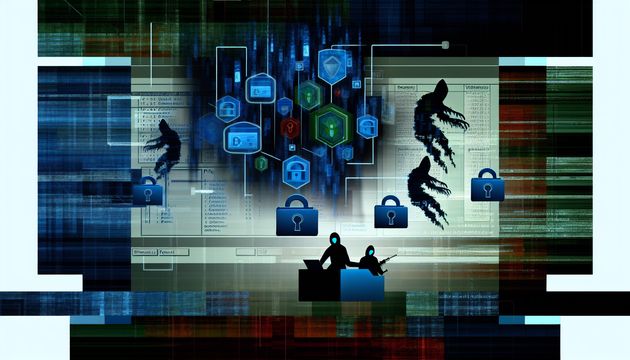
Unmasking FinalDraft: The Malware Hiding in Your Outlook Drafts
Picture a covert operation where your email drafts become a secretive communication channel. This is exactly how the FinalDraft malware functions, ingeniously using the drafts folder in Microsoft Outlook to connect with its command-and-control (C2) server. By avoiding direct internet communication, it dodges traditional security alerts, making detection a tough task. This malware further blends in by using the Microsoft Graph API, mixing its harmful traffic with legitimate cloud communications. These strategies highlight the advanced nature of modern cyber threats and the ongoing battle between cybersecurity experts and malicious actors. For more details on these tactics, see Cybersec Sentinel and Elastic Security Labs.
The Sneaky Tactics of FinalDraft: How Malware Plays Hide and Seek in Your Inbox
Exploiting Outlook’s Drafts Folder
Think of a spy using a dead drop to exchange secret messages without being noticed. Similarly, the FinalDraft malware uses the drafts folder in Microsoft Outlook to communicate with its command-and-control (C2) server. For those unfamiliar, a C2 server is like a remote control center that hackers use to send instructions to malware and receive data back. By storing commands in the drafts folder instead of sending them over the internet, the malware avoids triggering security alerts. This clever tactic allows it to blend in with normal email operations, making it hard for traditional security systems to detect. (Cybersec Sentinel)
Command-and-Control via Microsoft Graph API
FinalDraft’s stealthy use of the Microsoft Graph API for its C2 communications is akin to a chameleon blending into its surroundings. By integrating with a legitimate service, the malware’s traffic looks like regular cloud communications, reducing the chance of detection. The Graph API is a versatile tool for accessing Microsoft cloud services, which the malware exploits to issue commands and receive data. This technique not only hides the malware’s presence but also makes it harder to trace back to the attackers. The use of trusted services for malicious purposes highlights the challenges cybersecurity professionals face in identifying and mitigating such threats. (Elastic Security Labs)
Process Injection and Evasion Techniques
To stay hidden, FinalDraft uses advanced process injection techniques, much like a parasite living undetected within a host. By injecting its code into legitimate processes, such as mspaint.exe or svchost.exe, the malware can execute its payload without raising suspicions. This method allows it to operate under the guise of trusted applications, making it difficult for security software to differentiate between legitimate and malicious activities. Additionally, FinalDraft bypasses Windows Event Tracing (ETW) and the Antimalware Scan Interface (AMSI), further enhancing its ability to evade detection. These evasion techniques demonstrate the malware’s sophistication and the ongoing evolution of cyber threats. (Cybersec Sentinel)
Self-Deletion and Forensic Evasion
A notable feature of the Linux variant of FinalDraft is its ability to self-delete, effectively erasing forensic evidence after execution. This feature is key to keeping the attackers anonymous and complicating incident response efforts. By removing traces of its presence, the malware hinders forensic investigations and prolongs its undetected operation within compromised systems. This self-deletion mechanism highlights the need for proactive security measures and robust logging and monitoring solutions to catch suspicious activities before the malware can erase its tracks. (Cybersec Sentinel)
Phishing and Initial Infection Vectors
The initial infection vector for FinalDraft remains largely speculative, but evidence suggests that phishing emails play a significant role in its distribution. Attackers often use spear-phishing tactics to target specific individuals within organizations, crafting emails that appear legitimate and enticing recipients to open malicious attachments or click on harmful links. By compromising credentials or exploiting weak security controls, the attackers can establish a foothold within the target network. This initial access is crucial for deploying the PATHLOADER malware, which subsequently downloads and executes the FinalDraft RAT. The reliance on social engineering techniques highlights the need for comprehensive security awareness training to educate users about the risks of phishing and the importance of verifying email authenticity. (Cybersec Sentinel)
Recent Incidents and Statistics
In 2024, a similar malware incident involved the use of cloud services to mask malicious activities, resulting in a significant data breach affecting thousands of users. This incident underscores the growing trend of cybercriminals leveraging trusted platforms to carry out their attacks, making it imperative for organizations to stay vigilant and adopt advanced security measures.
Final Thoughts
The FinalDraft malware exemplifies the evolving landscape of cyber threats, where attackers increasingly exploit trusted platforms and sophisticated techniques to evade detection. Its use of Outlook’s drafts folder and the Microsoft Graph API highlights the need for advanced security measures and vigilance. As organizations face these challenges, the importance of comprehensive security awareness training and robust monitoring systems cannot be overstated. The 2024 incident involving cloud services further illustrates the pressing need for proactive cybersecurity strategies. For more insights into these incidents, refer to Cybersec Sentinel.
References
- Cybersec Sentinel. (n.d.). The Sneaky Tactics of FinalDraft: How Malware Plays Hide and Seek in Your Inbox. Retrieved from https://cybersecsentinel.com/finaldraft-malware-abuses-microsoft-services-stay-one-step-ahead/
- Elastic Security Labs. (n.d.). Command-and-Control via Microsoft Graph API. Retrieved from https://www.elastic.co/security-labs/finaldraft



